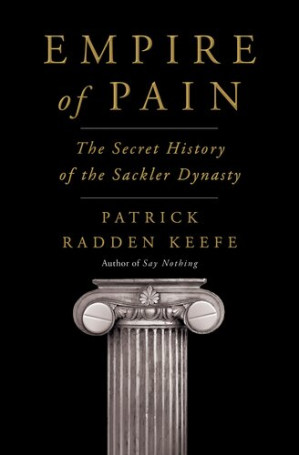Marketing can outrun science.
Purdue trained reps to call OxyContin addiction risk 'less than one percent' without data.

Book summary
by Patrick Radden Keefe
Philanthropy, marketing genius, and public health catastrophe collide in one American family
The Sackler dynasty's fortune and downfall amid the opioid crisis
Topics
Read chronologically but keep a parallel note stream: one for family history, one for marketing innovation, one for legal fallout. In Readever, link quotes about OxyContin's "abuse-deterrent" claims to the lawsuits they later triggered.
Things to know before reading
Investigative journalist Patrick Radden Keefe traces three generations of Sacklers—from the immigrant brothers who marketed Valium to the next wave that unleashed OxyContin. Drawing on depositions, leaked emails, and internal marketing decks, he shows how Purdue Pharma outmaneuvered regulators, rewrote pain-management norms, and hid addiction data even as overdoses soared. The book doubles as a study in reputational laundering through art museums and universities.
Empire building is easier than accountability when regulators, marketers, and nonprofits align.
Purdue trained reps to call OxyContin addiction risk 'less than one percent' without data.
Museum wings and university chairs kept the Sackler name prestigious while lawsuits mounted.
Activists, state AGs, and journalists coordinated to pierce corporate veils.
Ready to continue? Launch the Readever reader and keep turning pages without paying a cent.
Readever lets you capture each tactic—speakers bureaus, patient testimonials, grantmaking—to audit your own industry's vulnerabilities. Use the highlights to spark compliance conversations or public policy debates.
Key idea 1
Purdue trained reps to call OxyContin addiction risk 'less than one percent' without data.
Keefe shows how pseudo-academic pamphlets, pain-management conferences, and targeted bonuses spread misinformation faster than peer review. Readers learn to interrogate medical messaging, especially when sales incentives loom large.
Key idea 2
Museum wings and university chairs kept the Sackler name prestigious while lawsuits mounted.
By funding art and research, the family embedded itself in elite culture, making critics seem ungrateful. The lesson: follow the money but also the naming rights—they may hide harmful revenue streams.
Key idea 3
Activists, state AGs, and journalists coordinated to pierce corporate veils.
Only when multiple states sued, bankruptcy judges demanded disclosure, and museums refused donations did the Sackler brand crack. It's a blueprint for tackling other industries whose products cause widespread harm.
Keefe traces three generations of the Sackler family, from Arthur Sackler's advertising innovations for Valium to Richard Sackler's aggressive launch of OxyContin and the philanthropic empire that followed. The book shows how marketing, regulatory capture, and philanthropy intertwined to build—and protect—a fortune tied to addiction.
Open Readever's reader to highlight passages, ask the AI companion questions, and keep exploring without paying a cent.
Reviewers celebrate Keefe's ability to turn sprawling legal and medical history into propulsive narrative. The New York Times called it "a masterpiece of narrative reporting," while The Atlantic praised the way he "balances outrage with restraint." The book won the Baillie Gifford Prize and became a staple in discussions about corporate accountability.
Critical reception: Longlisted for the National Book Award, named one of the best books of 2021 by The Washington Post, Time, and NPR.
Healthcare leaders navigating marketing claims and compliance
Philanthropy and museum boards evaluating donor reputations
Journalists and policy students studying corporate accountability
Readers of *Bad Blood* or *The Radium Girls* seeking modern parallels
Patrick Radden Keefe is a staff writer at The New Yorker known for meticulous investigative features. His previous book Say Nothing won the Orwell Prize. Keefe studied at Columbia, Cambridge, and the London School of Economics and has received fellowships from the Guggenheim Foundation and the Cullman Center at the New York Public Library.
Build your personalized reading stack
Bundle this title with *The Radium Girls* and *Bad Blood* for an accountability reading lane.
Export a timeline of lawsuits and settlements straight from your highlights.
Tap into Readever's policy templates to turn insights into advocacy plans.
Track philanthropy references to rethink how you evaluate donors.
Sign in to Readever to keep reading with AI guidance, instant summaries, and synced notes.
Empire of Pain demonstrates that reputational polish cannot mask systemic harm forever. By tracing the Sacklers' ascent and unraveling their philanthropic shields, Keefe arms readers with a blueprint for interrogating any company that profits from addictive products.
Start reading Empire of Pain for free and unlock personalized book journeys with Readever.